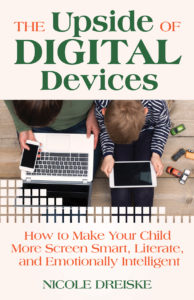Interview with Nicole Dreiske: ScreenSmart(tm) Kids Are Kinder, Smarter, Closer
Posted on May 2, 2018 at 8:54 pm
Fake news. Invasion of privacy. Bullying. Distraction. We are surrounded by complaints and fears about the impact of digital media on all of us, especially on our children. It is hard for parents to understand what it is like for the generation who cannot remember a time when people talked to each other for 15 minutes without checking their devices.
We cannot go backward. They are always going to be a part of our lives. But we can learn to use them better. Nicole Dreiske’s new book, The Upside of Digital Devices: How to Make Your Child More Screen Smart, Literate, and Emotionally Intelligent, is filled with thoughtful, constructive, guilt-free ideas about how to help families get the most and the best from the digital world. In an interview, she talked about how parents and teachers can make sure children are “screen smart” and use technology to make them smarter, kinder, and closer. It has some excellent tools for adults to use to improve their own relationship to devices, too. Her most important advice: model good behavior yourself because that is the most powerful lesson.

It drives me crazy when I see children in the back of a car looking at devices instead of talking, listening to music, or just looking out the window. Am I wrong?
Putting DVD players in cars paved the way to the passback phenomenon when parents who were driving surrendered their phones to young children. The family car became an extended screening room dedicated to eradicating the possibility that children will spend a nanosecond without external entertainment. Just because we can put screens in cars doesn’t mean we should.
It’s a great loss to children and parents, masquerading under the guise of a convenience. If you give children yet another chance to spend time with “the adult free zone” of screens you’re just losing another great time to connect with your kids and turning yourself into a chauffeur.
Travel, even in predictable short distances, can broaden the mind and uplift the spirit. I’ve had great conversations during windscreen time, been amazed by the beauty of the sky and by gazing out at the human condition. More importantly, on long trips I was forced to spend time with my own mind something that’s crucial for developing grit, persistence and self-awareness. Yep, you can get all that from a long car trip if you’re not glued to a screen.
We’re cheating our children, cheapening a precious opportunity and creating habits of isolation rather than habits of connection by letting screens dominate the interior landscapes of our vehicles.
Many people think that digital media and devices shorten attention spans. Do you agree?
Yes. Any early childhood teacher who’s taught for a couple of decades will tell you that the shortened attention span is real. First, commercials took a toll on attention span with the expectation that there would be programming breaks every five minutes or so. The endless exposure to short YouTube videos also has a lot to answer for. But the more pernicious problem is the slavish devotion to instant response that drives software development because it creates then exploits your expectation that you’ll be amused (aka distracted) by the visual effects of a swipe or cool graphics during every nanosecond of screen time. This “cool upgrade” not only shortens attention spans, it functionally infantilizes children and adults, reducing not only our ability to focus, but the emotional stability to tolerate any disturbance in the delivery of desired images or actions. Fostering dependence on instant gratification is a slippery slope since we know that patience and self control are some of the most accurate and consistent predictors of success in later life.
What is the best way for families to counter fake news messages that kids and adults receive online, especially in social media?
This is a complex question because so many adults are still struggling to figure out how to counter fake news, especially with the advent of new software that is so powerful that it can manipulate public figures.
First, you need to have good communication structures in place with your children. This means that listening, caring Q & A, and sharing (the hallmarks of real dialogue) are in your wheelhouse along with “laying down the rules.”
Second, have a plan and practice. Start with a fake news topic that unifies your family beliefs and sympathies, rather than with a fake news topic that’s divisive. Building a practice on common ground is better than building a practice on shifting terrain.
Third, involve your kids directly in finding the truth. They’re creative and resourceful and can contribute to the solution in ways that help them learn! A lot depends on the topic and on the ages of your children but I think the best family practices are active and build on children’s strengths and interests.
-Frame ‘the search for facts’ as a challenge for older kids and a game for younger children to find out more about the topic and make it fun to share what they find.
-Teach them how to use keywords and “dig” through the internet.
-Show them the best de-bunking sites, and how to assess and compare the merits of something they’ve read.
-Let them show off and share at the dinner table or a family meeting.

What is the best way for parents and schools to prevent/respond to bullying via social media?
Stop handing kids powerful machines and walking away. You can’t just do a “tech drop” and expect your kids to know how to handle one of the most powerful devices ever created. The internet alone gives them worldwide access to unlimited content and information without the maturity, brain development, empathy or guidance to know what to do with that access. Again, for parents the answer lies in good communication skills.
You already teach your children social skills, empathy and civility by example and instruction. Because digital devices are social media tools, it’s logical for us to extend those social skills to phones, tablets and computers.
At home or in school, start the ball rolling by helping children understand bullying before they have social media accounts. Talk in simple terms about what bullying is, let them know it’s unacceptable and make sure they know how to get help. Schools can offer digital citizenship classes at all grade levels. Then keep the lines of communication open by checking in (really listening and checking in often) about school, friends, non-friends and concerns.
What does it mean to be “screen smart” and how can parents demonstrate good device skills and behavior?
Being screen smart is an active, fun process. It means you’re aware of yourself and your responses, not just what’s on the screen. And it’s something kids learn quickly because they love screens and love talking about their experiences.
The best part is that they’re in control of what they learn. They know when they’re being screen smart and when they’re not. Layer by layer, they put all the skills together and they use them they want to be screen smart.
Here’s a short Screen SmartTM primer.
· When I turn on a screen, I use my energy and concentration to keep my mind awake.
· I notice what I’m thinking and feeling while using the screen.
· I especially notice what I like, what I don’t like and why.
· I notice DETAILS in movies, games, apps — plot, character, setting, music, dialogue, problem, solution, effects, colors, shapes.
· I talk about what I watch and what I feel and think about what I see on any screen.
Parents can start the process by opening the door to dialogue and by not segregating screen time from family time. Just letting your kids know they can come to you with their questions, fears or concerns about screen experiences gives the process big boost. Then make sure you’re modeling healthy screen habits yourself! If you’re phone-obsessed yourself and your kids see you texting and talking while driving, all bets are off.
Should families put limits on screen time?
Don’t you put limits on bed-time? Candy? Sugary drinks? Kids need structure in order to thrive and limits on screen time are part of those structures because screens are part of family life.
Set screen limits early and stick to them. When you establish those limits as a basic family structure without drama, they’re easier to sustain
But don’t expect limits to do the heavy lifting when it comes to talking with children about content, good screen citizenship and screen etiquette. Limits are a starting point, not an endgame. You can actually use a talk about limits to start giving children guidance about screens and opening the door to dialogue that I mentioned earlier.
What can schools do to emphasize the “upside” of digital media?
Start making classroom connections to “the stories on screens” so young children know that stories aren’t just in books, assign “media reports” for narrative fiction films or programs and provide the same guidelines and structures that you would for a book report. Make sure kids are taking home their literacy skills and applying them to screens. Adopt a school wide “digital citizenship” curriculum as the first mainstay against bullying. Become a phone free school and have children keep their phones in their lockers. And when the weather drives kids indoors during for recess, don’t stick them in front of screens for mindless viewing!
And you can reach out to me at the ICMC. I’m here to help and I’ve taught thousands of children and teachers how to turn on their minds before turning on their screens.
What differences do you see in kids who have become “screen smart?”
Too many to share! We chart ten outcomes including improved literacy skills and inferential reasoning, but here are my top two for the homefront:
When kids can notice and talk about how they feel while playing games and watching movies, they start communicating with their parents about their screen time experiences and making more mature screen choices on their own. That’s been the case since the very first Screen Smart residency where teachers told us that children only three or four years old were telling their parents to turn off the tablet or the tv!
Just last year an astonished parent reached out to me, saying, “My son was watching something on our television and told me to turn it off because he wasn’t being screen smart.”
Children also start developing and building kindness and empathy by focusing on how the characters are feeling. Kids who are screen smart pick up on the details that convey emotions, for example, facial expressions, body language and tone of voice. As they get better at identifying the feelings of others, they also make empathetic connections: What if that happened to me, how would I feel? What would I do differently in that situation? Screen smart skills help kids connect emotional intelligence to screen use so they practice it every time they watch, or use an app or play a gain. Empathy and compassion are like muscles. You have to use them to develop them. Imagine how much more empathetic your children will be if they exercise those kindness and empathy muscles regularly while using screens.
